What Was The Ethnic Background Of Most American Jews Before The 1880s?
The demographic profile of Jewish Americans is distinctive in several ways. Compared with the overall public, the Jewish population is older, has relatively high levels of educational attainment and is geographically full-bodied in the Northeast.
Jewish adults ages xl to 59 as well accept slightly fewer children, on average, compared with the general public. However, Orthodox Jews have much higher fertility rates and live in larger households than non-Orthodox Jews.41
The rest of this affiliate provides farther item on the demographic characteristics (including fertility rates and household sizes) of Jewish Americans. Information technology also looks at the self-described sexual orientation of U.South. Jews.
Fertility
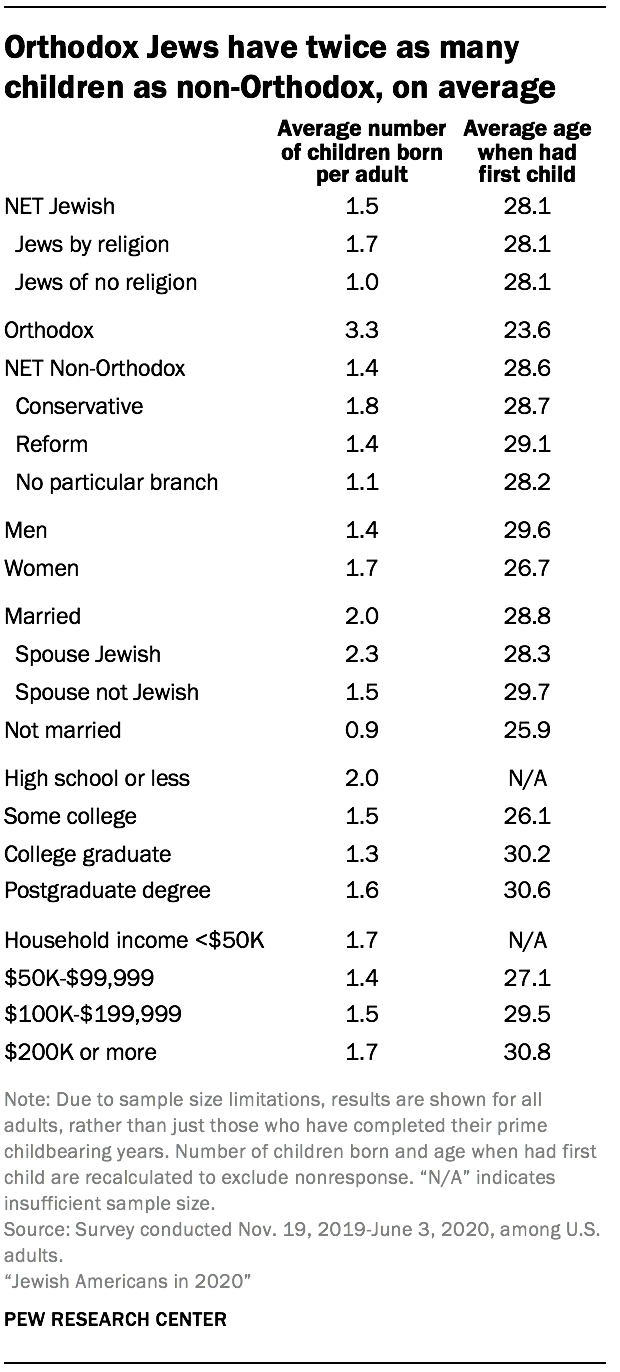 In the 2020 survey, Jewish adults ages 40 to 59 study having had an average of 1.9 children, the same as in the 2013 survey and slightly below the comparable figure for the full general U.S. public, which is 2.3 children per developed in the same age cohort.42 While some adults in this age range may continue to deport children, this statistic is a rough measure of the completed fertility of this cohort.
In the 2020 survey, Jewish adults ages 40 to 59 study having had an average of 1.9 children, the same as in the 2013 survey and slightly below the comparable figure for the full general U.S. public, which is 2.3 children per developed in the same age cohort.42 While some adults in this age range may continue to deport children, this statistic is a rough measure of the completed fertility of this cohort.
However, to increase the reliability of comparisons across subgroups of Jews, this study also uses information from all adults in the survey. This includes immature adults in their prime childbearing years (who may requite birth to additional children in the future) as well as older adults (who may already have had all the children they intend to bear).
Based on reports from adults of all ages, the survey finds that, on boilerplate, Jews by religion accept more children than Jews of no faith (1.7 vs. 1.0), and Jews with spouses who are as well Jewish accept more than offspring than religiously intermarried Jews (2.iii vs. 1.5).
The survey also indicates that fertility among Orthodox Jews is at least twice as high as among non-Orthodox Jews. Orthodox Jewish adults report having an boilerplate of 3.3 children, while not-Orthodox Jews have an average of ane.iv children. Orthodox Jews also are five years younger, on boilerplate, when they give birth to their first child (23.6 vs. 28.6 among non-Orthodox Jews).
Fertility differences between Jews and the general public are driven in part by the greater share of Jewish women who have never had children. Amid women ages forty to 59, Jews are twice every bit likely to take no children (20% vs. 10%).
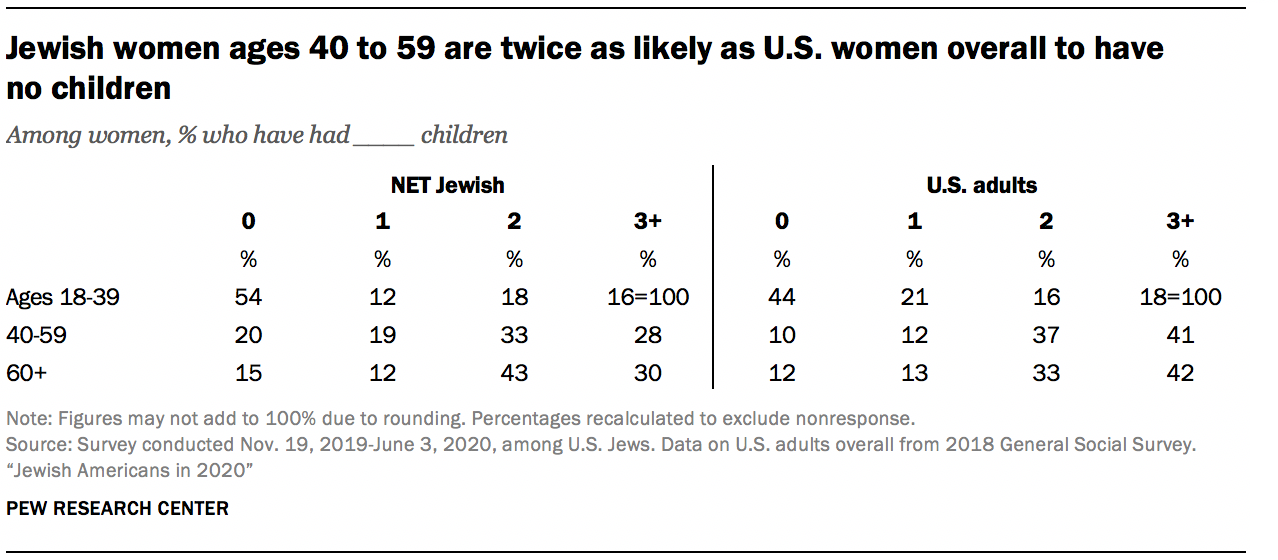
Household size and limerick
The average U.Due south. Jew lives in a household of ii.7 people, including 2.1 adults and 0.6 children. Overall, the average size of Jewish households has not inverse much since the 2013 survey.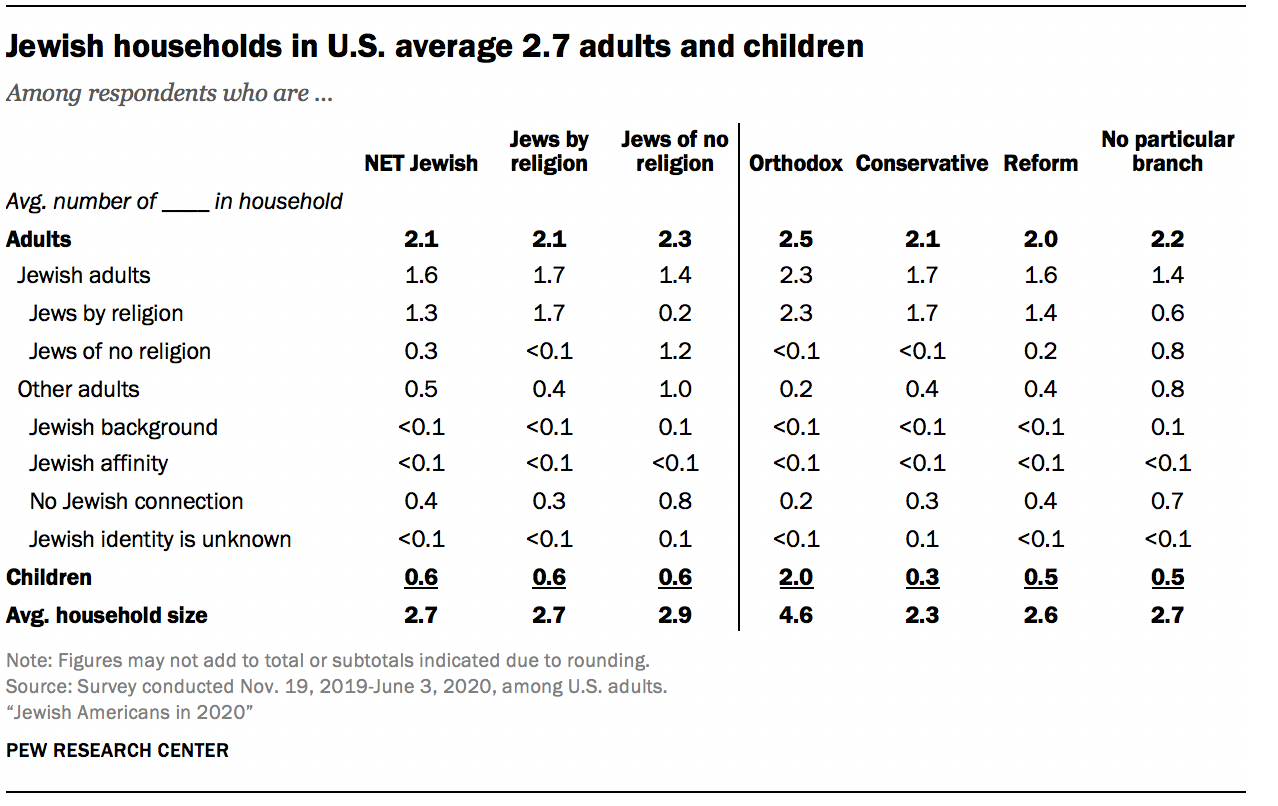
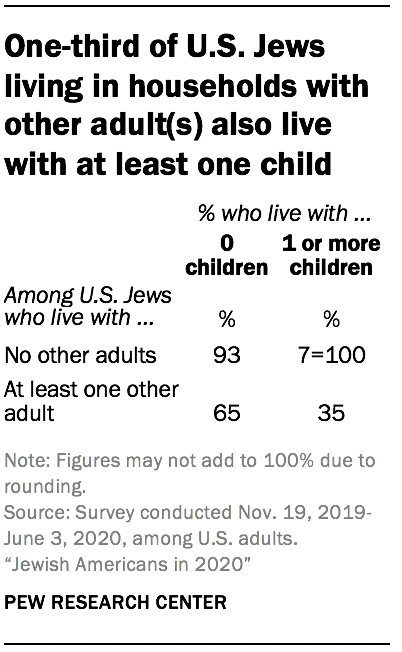 Orthodox Jews tend to live in much larger households than Jews who identify with other branches or streams of American Judaism. The average Orthodox household in the survey contains 2.0 children, compared with 0.3 children per household among Bourgeois Jews and 0.5 children per household among Reform Jews.
Orthodox Jews tend to live in much larger households than Jews who identify with other branches or streams of American Judaism. The average Orthodox household in the survey contains 2.0 children, compared with 0.3 children per household among Bourgeois Jews and 0.5 children per household among Reform Jews.
As of 2020, well-nigh 1-tertiary of Jewish adults who alive with at least one other developed (who could be, but is not necessarily, a spouse or partner) take children living in the household. It is much less common for Jews who are the sole adult in their household to accept children living with them.
Age
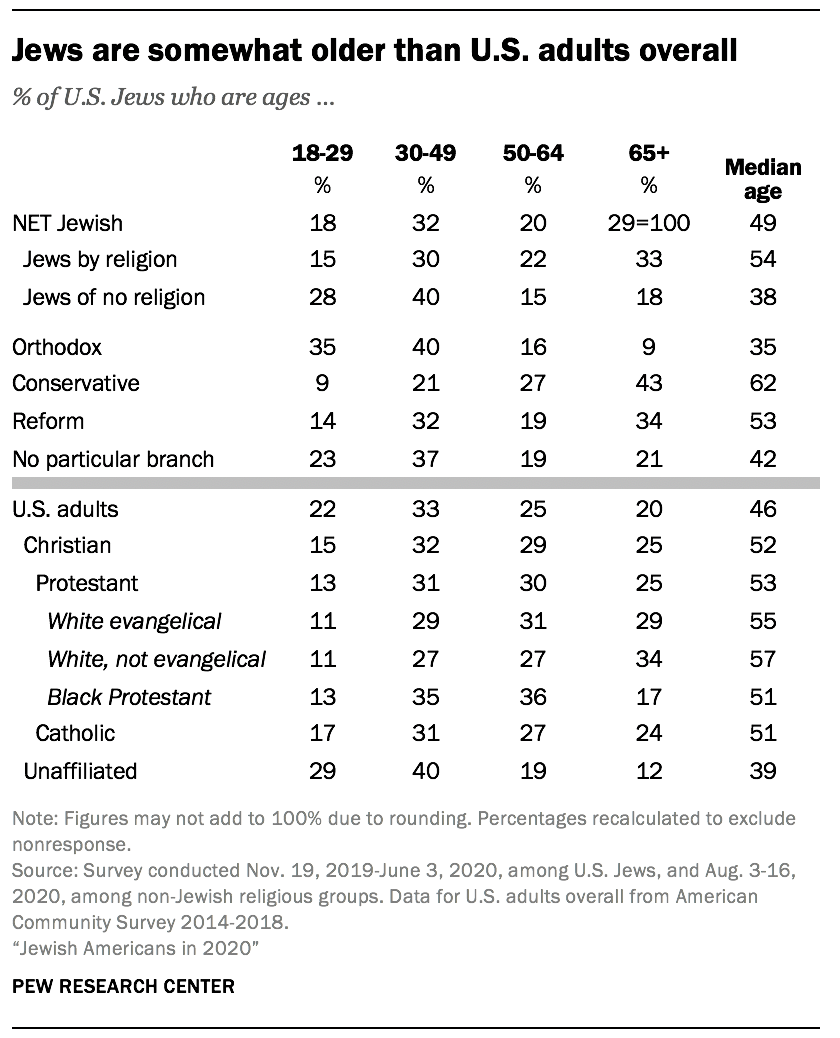 The survey finds that, on average, Jewish adults are older than the U.Southward. public every bit a whole. But a closer look reveals that this is true simply for Jews by organized religion. Jews of no religion, on average, are younger than U.Due south. adults overall.
The survey finds that, on average, Jewish adults are older than the U.Southward. public every bit a whole. But a closer look reveals that this is true simply for Jews by organized religion. Jews of no religion, on average, are younger than U.Due south. adults overall.
Among adults, the median age in the Jewish population is 49 – slightly older than the median age of adults in the general public (46). Jews by religion (adult median historic period of 54) are like in age to U.S. Protestants (53), and Jews of no organized religion (median age of 38) are similar in age to religiously unaffiliated people in the broader U.S. population (39).
Looked at another manner, roughly half of Jewish adults are ages fifty and older (49%), compared with 45% of adults in the full general public. Amid Jews by religion, 56% are 50 and older, compared with just 32% of Jews of no religion.
Orthodox Jews (median age of 35 among adults) are substantially younger than Bourgeois Jews (62) and Reform Jews (53).
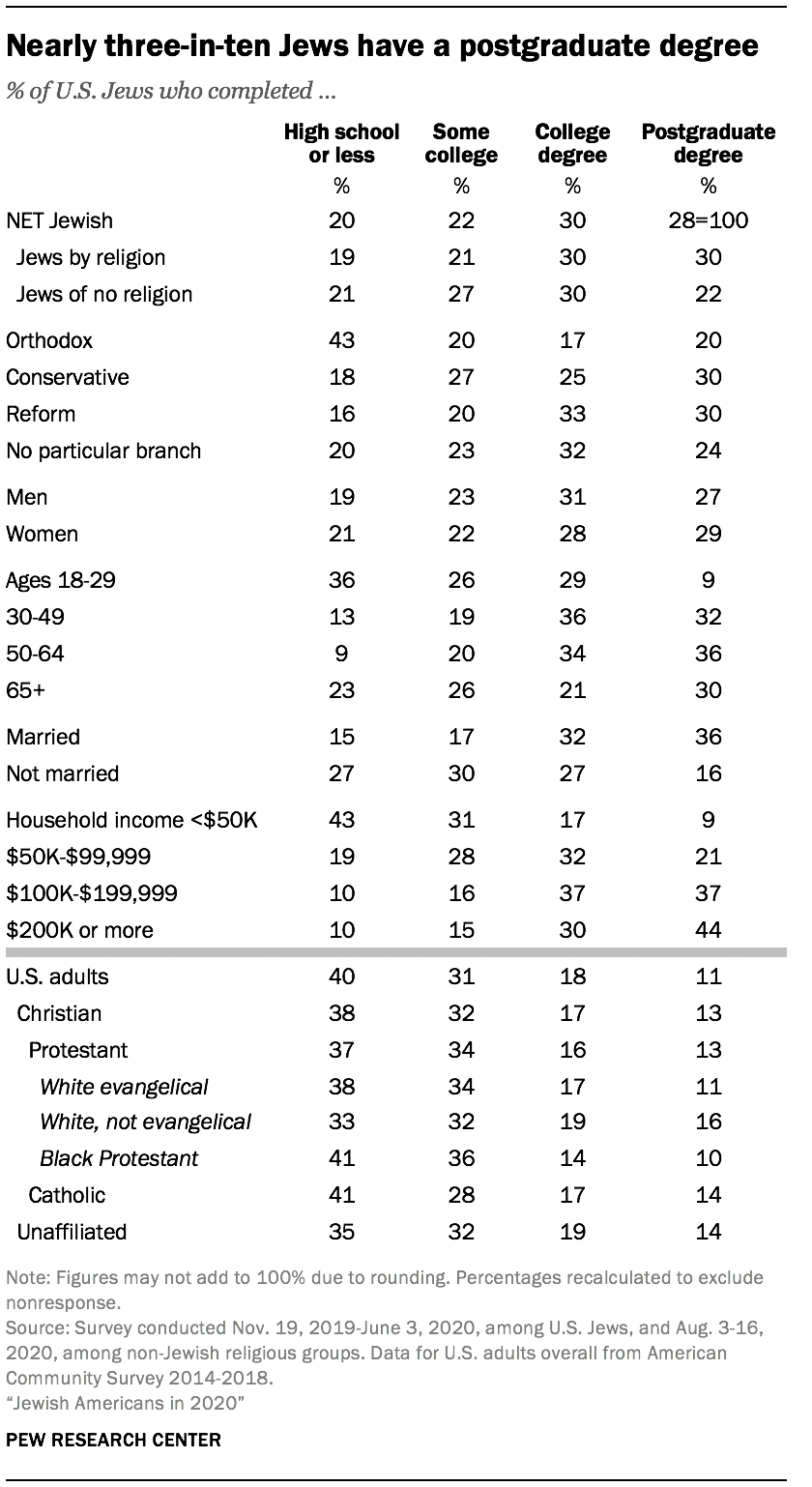 Didactics
Didactics
U.S. Jewish adults are, on the whole, a comparatively well-educated group. About six-in-ten are higher graduates, including 28% who have obtained a postgraduate degree. By comparing, amongst U.Due south. adults overall, well-nigh iii-in-ten are college graduates, including 11% who have a postgraduate degree. Both Jews by religion and Jews of no religion have much higher levels of educational attainment, on average, than does the public overall.
Most ii-thirds of Reform Jews (64%) say they are college graduates, equally practice 57% of Jews with no denominational affiliation and 55% of Bourgeois Jews. Fewer Orthodox Jews (37%) report having higher degrees.
Sexual orientation amidst U.Due south. Jews
The survey finds that 4% of U.S. Jews identify as gay or lesbian, and an additional five% say they are bisexual. About nine-in-ten U.Southward. Jews (88%) say they are direct. Compared with Jews by religion, somewhat fewer Jews of no faith say they think of themselves as directly (81% vs. 91%). Instead, Jews of no religion are more probable than Jews by faith to say they are bisexual (10% vs. 3%).
Older Jews are more than likely than younger Jews to say they are straight. Fully 96% of Jewish adults ages 65 and older say they are straight, as do 93% of those betwixt the ages of fifty and 64. Fewer Jewish adults in their 30s and 40s (85%) and under xxx (75%) identify as straight.
The per centum of Jewish adults who identify as straight (88%) is like to the share of the overall U.Southward. public that identifies that way (89%). And the share of Jewish adults under thirty who depict themselves every bit straight is on par with the share of U.South. adults under the age of 30 who say the same (78%).
This question asked about U.Southward. Jews' sexual orientation; information technology did not measure transgender identity.
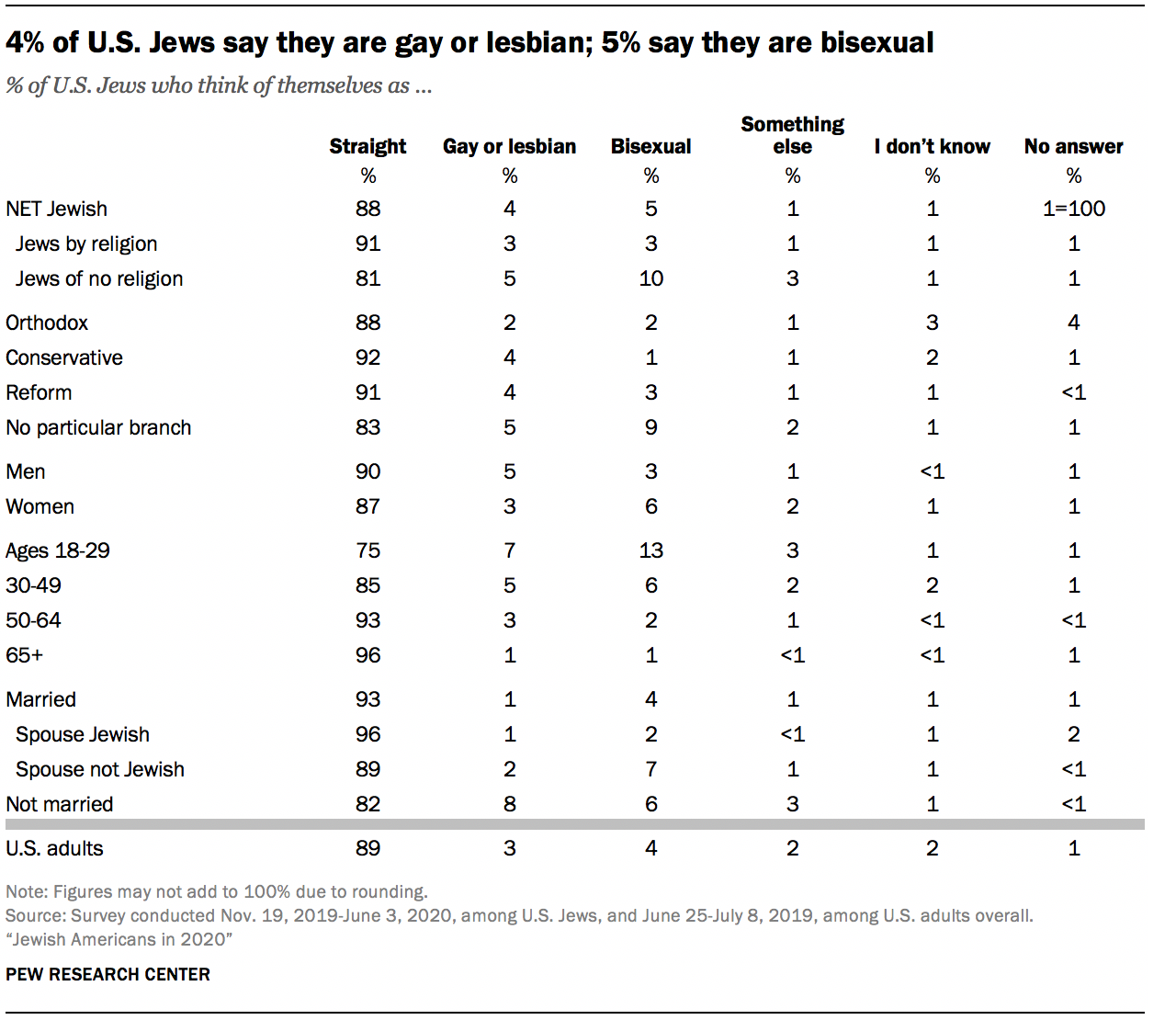
Geographic distribution
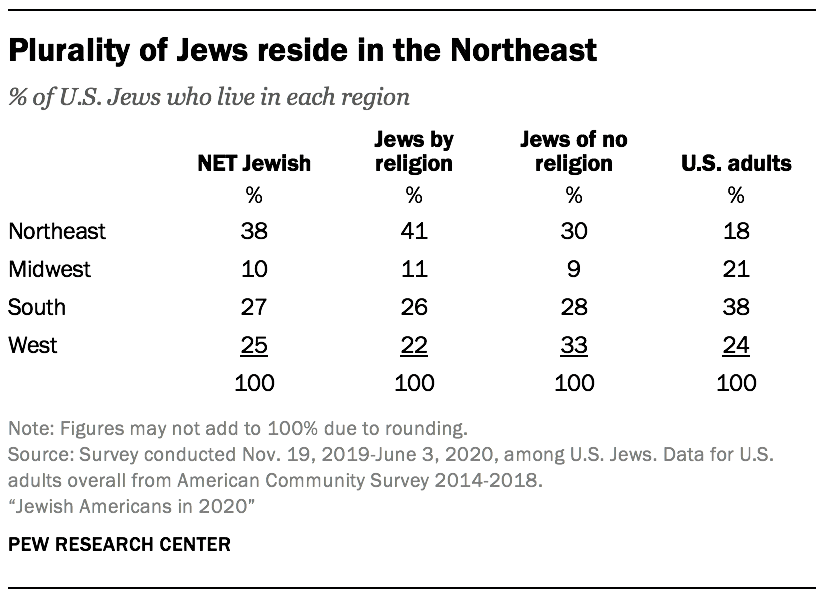 About 4-in-ten Jewish adults (38%) live in the Northeast – roughly double the share of U.South. adults overall who alive in that demography region (xviii%). A quarter of Jewish Americans reside in the West (25%), and a similar share live in the South (27%). Just one-in-ten Jewish adults alive in the Midwest.43
About 4-in-ten Jewish adults (38%) live in the Northeast – roughly double the share of U.South. adults overall who alive in that demography region (xviii%). A quarter of Jewish Americans reside in the West (25%), and a similar share live in the South (27%). Just one-in-ten Jewish adults alive in the Midwest.43
Compared with Jews by religion, Jews of no religion are somewhat more evenly distributed across the Northeast, South and West.
What Was The Ethnic Background Of Most American Jews Before The 1880s?,
Source: https://www.pewresearch.org/religion/2021/05/11/jewish-demographics/
Posted by: gentrysaughts1992.blogspot.com


0 Response to "What Was The Ethnic Background Of Most American Jews Before The 1880s?"
Post a Comment